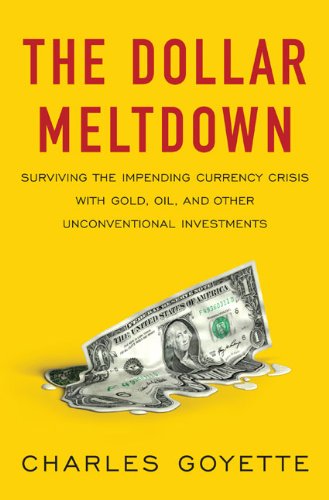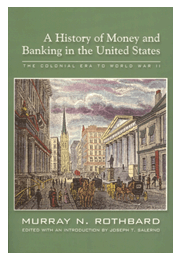
The Dollar Meltdown: Surviving the Impending Currency Crisis with Gold, Oil, and Other Unconventional Investments
By Charles Goyette
Portfolio 2009
248 pages. $27.95
The Dollar Meltdown is definitely a gloom and doom book. Fortunately, the author’s style of writing and enthusiasm for his subject – how to avoid the doom – keep the book from being depressing. Charles Goyette – the author – simply tells it like it is. And what it is, is a sad state of affairs. Goyette’s presentation is composed of four parts: where we are; how we got here; what happens next; and what to do.
Under the heading of ‘where we are,’ Goyette points out that “the future of the dollar has already been determined.” For all intents and purposes, the dollar is dead. It has lost “96 percent of its purchasing power under the Federal Reserve System’s mismanagement.” Along with a valueless dollar, Goyette makes it abundantly clear where we are:
From January 2007 to 2009, 5.1 million jobs were lost; 13.7 million people were out of work and 32.2 million people were on welfare (food stamps). Retirement plans are all but worthless. $9.7 trillion was spent on bailouts. An astonishing number of homes – 19 million – stand vacant. U.S. debt is approximately $12 trillion.
Goyette then proceeds to discuss the great bailout, which he equates to robbing Peter to “subsidize a few hundred banking Pauls.” The result is massive debt. He quotes David Walker, the former comptroller general of the United States, who said, “The system is broken.” In a nutshell, Walker’s statement pretty much sums up where we are.
The second section of the book talks about ‘how we got here.’ Goyettes begins by showing how gold came to “serve as money.” Nations whose economies are based on precious metals are healthy. Those that aren’t, fail. During the Civil War, America first forsook gold and silver. However, by 1879, the country went back to the gold standard. Then in 1934, private ownership of gold was abolished. And in 1971, Nixon chose to go off the gold standard. At that point, inflation took over.
Goyette provides historical examples of what happens when governments choose paper money over the gold standard. He cites China, the Roman Empire, the French Revolution, Germany, and Zimbabwe, where the annual inflation rate “hit 231 million percent in the summer of 2008.”
According to Goyette, the Federal Reserve System is leading America down the same path as Zimbabwe. “Inflation in the U.S. is a result of the Federal Reserve turning government money into debt.” The result is bad investments. “People and businesses make decisions n ways they otherwise would not.” In other words, legitimate investments are replaced by speculation, which is the same thing as gambling. Roll the dice and hope you get lucky. Which means that long-term planning – savings – is cast aside.
In ‘what happens next,’ Goyette predicts that repudiation of debt is looming on the horizon. The forerunner of repudiation is deflation, which, according to Goyette, is what is taking place in real estate values. And the only way governments can fight deflation is by printing money. This leads to “stagflation,” which is “a period of economic stagnation accompanied by inflation.” Somewhere in this scenario, “cash is trash.” Which is when “the crack-up boom” occurs. If and when the crack-up does happen, runaway inflation is the result. And runaway inflation cannot be contained.
Goyette then discusses the precarious position of King Dollar. As he points out, China is the largest foreign holder of Treasury debt. China was also “the largest foreign holder of Fannie and Freddie debt.” When the federal government guaranteed those holdings, they compounded the problem. The only way those guarantees can be effected is by borrowing “more money from … places like China and Japan.”
Since approximately half of U.S. currency is held outside the U.S., if the holders of those dollars begin dumping them, the U.S. would have a very serious problem. The dollar would topple like Humpty Dumpty.
All the aforementioned factors have resulted in what Goyette calls “a command economy.” He defines a command economy as one that “orders the affairs of a nation by coercion.” The government “set prices, controls and directs resources, and oversees production and consumption.” According to Goyette, a command economy leads to poverty. Prosperity, on the other hand, is the offspring of free market economies.
Goyette believes the situation will inevitably lead to wage and price controls and then rationing.
The fourth and final section of the book is ‘what to do.’ Goyette says “there is opportunity in every crisis.” To that end, he offers four categories of investment recommendations. The first recommendation is real money, which means gold and silver. Goyettes suggests putting 25% of your portfolio in “physical gold and silver that you take in your possession.” And you should deal with “a precious metals broker because of their capabilities.”
His second investment recommendation is oil, specifically the United States Oil Fund. Others are mentioned, but his “core recommendation” is the USO. The third recommendation is “real things,” by which he means agriculture and natural resources. ETFs and/or ETNs are his preferred methods of making such investments. And he mentions a number of funds by name.
Goyette’s final recommendation is bonds, which is a little startling until you read through his reasoning. Then it makes sense. His core recommendation is Rydex Inverse Government Long Bond Strategy Fund.
Whether or not investors agree with Goyette’s recommendations, The Dollar Meltdown is a productive read. The author presents his analysis of the present economic situation in grand style, using historical analogies, quotes, and entertaining anecdotes. Plus, what he has to say makes a lot of sense.
![]() On the Read-O-Meter, which ranges from 1 star (pretty bad) to 5 stars (pretty darn good), The Dollar Meltdown thaws 5 stars.
On the Read-O-Meter, which ranges from 1 star (pretty bad) to 5 stars (pretty darn good), The Dollar Meltdown thaws 5 stars.

